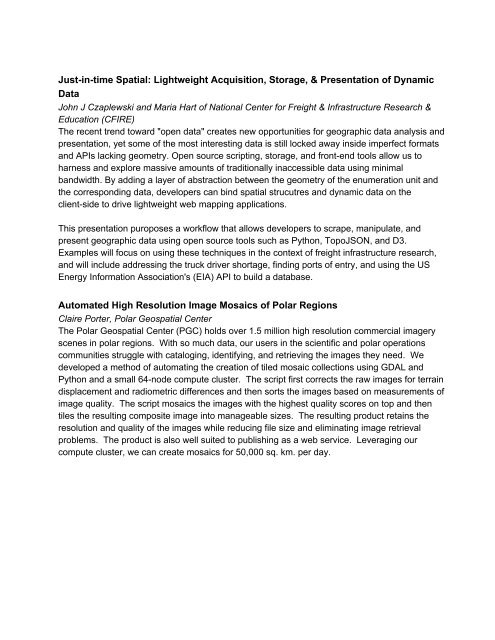FOSS4G North America Conference 2013 Preliminary Program
FOSS4G North America Conference 2013 Preliminary Program
FOSS4G North America Conference 2013 Preliminary Program
You also want an ePaper? Increase the reach of your titles
YUMPU automatically turns print PDFs into web optimized ePapers that Google loves.
Justintime Spatial: Lightweight Acquisition, Storage, & Presentation of Dynamic<br />
Data<br />
John J Czaplewski and Maria Hart of National Center for Freight & Infrastructure Research &<br />
Education (CFIRE)<br />
The recent trend toward "open data" creates new opportunities for geographic data analysis and<br />
presentation, yet some of the most interesting data is still locked away inside imperfect formats<br />
and APIs lacking geometry. Open source scripting, storage, and frontend tools allow us to<br />
harness and explore massive amounts of traditionally inaccessible data using minimal<br />
bandwidth. By adding a layer of abstraction between the geometry of the enumeration unit and<br />
the corresponding data, developers can bind spatial strucutres and dynamic data on the<br />
clientside to drive lightweight web mapping applications.<br />
This presentation puroposes a workflow that allows developers to scrape, manipulate, and<br />
present geographic data using open source tools such as Python, TopoJSON, and D3.<br />
Examples will focus on using these techniques in the context of freight infrastructure research,<br />
and will include addressing the truck driver shortage, finding ports of entry, and using the US<br />
Energy Information Association's (EIA) API to build a database.<br />
Automated High Resolution Image Mosaics of Polar Regions<br />
Claire Porter, Polar Geospatial Center<br />
The Polar Geospatial Center (PGC) holds over 1.5 million high resolution commercial imagery<br />
scenes in polar regions. With so much data, our users in the scientific and polar operations<br />
communities struggle with cataloging, identifying, and retrieving the images they need. We<br />
developed a method of automating the creation of tiled mosaic collections using GDAL and<br />
Python and a small 64node compute cluster. The script first corrects the raw images for terrain<br />
displacement and radiometric differences and then sorts the images based on measurements of<br />
image quality. The script mosaics the images with the highest quality scores on top and then<br />
tiles the resulting composite image into manageable sizes. The resulting product retains the<br />
resolution and quality of the images while reducing file size and eliminating image retrieval<br />
problems. The product is also well suited to publishing as a web service. Leveraging our<br />
compute cluster, we can create mosaics for 50,000 sq. km. per day.


